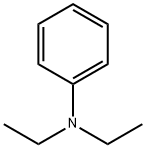Diethylamine , StandardforGC,≥99.5%(GC) , 109-89-7
Synonym(s):
Diethamine;Diethylamine;N-Ethylethanamine
CAS NO.:109-89-7
Empirical Formula: C4H11N
Molecular Weight: 73.14
MDL number: MFCD00009032
EINECS: 203-716-3
PRODUCT Properties
| Melting point: | -50 °C (lit.) |
| Boiling point: | 55 °C (lit.) |
| Density | 0.707 g/mL at 25 °C (lit.) |
| vapor density | 2.5 (vs air) |
| vapor pressure | 14.14 psi ( 55 °C) |
| refractive index | n |
| Flash point: | −20 °F |
| storage temp. | Store below +30°C. |
| solubility | H2O: soluble1M at 20°C, clear, colorless |
| form | Liquid |
| pka | 11.02(at 40℃) |
| color | Clear colorless |
| Odor | Ammoniacal; sharp, fishy. |
| Relative polarity | 0.145 |
| PH | 13 (100g/l, H2O, 20℃) |
| PH Range | Strong alkaline |
| Odor Threshold | 0.048ppm |
| Odor Type | ammoniacal |
| explosive limit | 2.0-11.8%(V) |
| Water Solubility | soluble |
| Sensitive | Air Sensitive |
| Merck | 14,3111 |
| BRN | 605268 |
| Henry's Law Constant | 2.56(x 10-5 atm?m3/mol) at 25 °C (Christie and Crisp, 1967) |
| Exposure limits | NIOSH REL: TWA 10 ppm (30 mg/m3), STEL 25 ppm (75 mg/m3), IDLH 200
ppm; OSHA PEL: TWA 25 ppm; ACGIH TLV: TWA 5 ppm, STEL 15 ppm (adopted). |
| Dielectric constant | 3.7(20℃) |
| Stability: | Stable. Highly flammable. Incompatible with strong oxidizing agents. |
| InChIKey | HPNMFZURTQLUMO-UHFFFAOYSA-N |
| LogP | 0.58 at 20℃ |
| CAS DataBase Reference | 109-89-7(CAS DataBase Reference) |
| NIST Chemistry Reference | Ethanamine, N-ethyl-(109-89-7) |
| EPA Substance Registry System | Diethylamine (109-89-7) |
Description and Uses
Diethylamine is a colourless, strongly alkaline, fish odour liquid, and highly inflammable. It has an ammonia-like odour and is completely soluble in water. On burning, diethylamine releases ammonia, carbon monoxide, carbon dioxide, and nitrogen oxides. Diethylamine is used in the production of pesticides. It is used in a mixture for the production of DEET which goes into the repellents that are found readily in supermarkets for general use.
Diethylamine is manufactured by heating ethyl chloride and alcoholic ammonia under pressure or by hydrogenation of aziridines in the presence of catalysts. DEA is used as a solvent, as a rubber accelerator, in the organic synthesis of resins, dyes, pesticides, and pharmaceuticals, in electroplating, and as a polymerization inhibitor. Other applications include uses as a corrosion inhibitor. It was reported noneffective as a skin depigmentator.
Safety
| Symbol(GHS) |    GHS02,GHS05,GHS06 |
| Signal word | Danger |
| Hazard statements | H225-H302+H332-H311-H314-H335 |
| Precautionary statements | P210-P280-P301+P312-P303+P361+P353-P304+P340+P310-P305+P351+P338 |
| Hazard Codes | F,C |
| Risk Statements | 11-20/21/22-35 |
| Safety Statements | 16-26-29-36/37/39-45-3 |
| OEB | A |
| OEL | TWA: 10 ppm (30 mg/m3), STEL: 25 ppm (75 mg/m3) |
| RIDADR | UN 1154 3/PG 2 |
| WGK Germany | 1 |
| RTECS | HZ8750000 |
| F | 10-23 |
| Autoignition Temperature | 594 °F |
| TSCA | Yes |
| HazardClass | 3 |
| PackingGroup | II |
| HS Code | 29211990 |
| Hazardous Substances Data | 109-89-7(Hazardous Substances Data) |
| Toxicity | LD50 orally in rats: 540 mg/kg (Smyth) |
| IDLA | 200 ppm |
| 発がん性評価について | ACGIH A4 |




